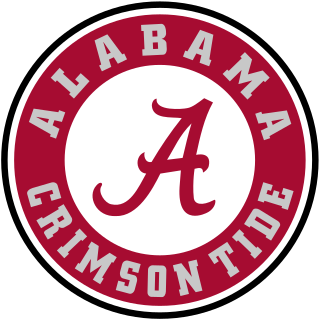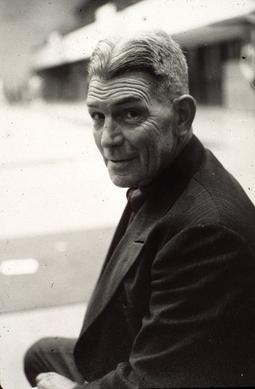
Michael Davis is an American basketball coach at the University of Memphis. Prior to that he was most recently the head men's basketball coach at the University of Detroit Mercy, a position he held from 2018 to 2024. Davis also served as the head men's basketball coach at Indiana University Bloomington from 2000 to 2006, the University of Alabama at Birmingham (UAB) from 2006 to 2012, and Texas Southern University from 2012 to 2018.
Charles Martin Newton was an American collegiate basketball player, coach, and athletics administrator. He served as the head men's basketball coach at Transylvania University from 1956 to 1968, the University of Alabama from 1968 to 1980, and Vanderbilt University from 1981 to 1989, compiling a career college basketball coaching record of 509–375. He was chairman of the NCAA Rules committee from 1979 to 1985 and was the president of USA Basketball from 1992 to 1996.

The Alabama Crimson Tide men's basketball team represents the University of Alabama in NCAA Division I men's basketball. The program plays in the Southeastern Conference (SEC). Among SEC teams it trails only long-time basketball powerhouse Kentucky in SEC tournament titles, is third behind Kentucky and Tennessee in SEC regular season conference titles, and is fourth behind Kentucky, Texas, and Arkansas in total wins. Alabama was retroactively recognized as the pre-NCAA tournament national champion for the 1929–30 season by the Premo-Porretta Power Poll. The team has appeared in the NCAA tournament 24 times, most recently in 2024, and has made ten Sweet Sixteens, two Elite Eights, and one Final Four in the tournament. Alabama's current head coach is Nate Oats.
David A. Hobbs is an American former basketball coach. Hobbs previously served as a special assistant to Iowa State's head coach Steve Prohm. He was the men's head coach at the University of Alabama from 1992 to 1998 and also was an assistant coach at Alabama, the University of Kentucky and Virginia Commonwealth University (VCU).

Charles H. "Sonny" Smith is a retired American college basketball coach. Originally from Roan Mountain, Tennessee, Smith served as a head coach for 22 seasons. Best known as the head coach at Auburn from 1978 to 1989, he also coached at East Tennessee State (1976–1978) and VCU (1989–1998). Smith won the 1985 SEC tournament championship while at Auburn, and won both the CAA regular season and tournament titles in 1996 while at VCU. He made six NCAA tournament appearances as a head coach, five at Auburn and one at VCU. Smith was inducted into the Alabama Sports Hall of Fame in 2007.
Loyd Hayden Riley was an American college basketball coach. He was the head coach of the Alabama Crimson Tide for eight seasons during the 1960s, and the Tide's head baseball coach for ten seasons in the 1970s. Riley was also a recruiting coordinator for football at Alabama under Paul "Bear" Bryant.

Henry Gorham Crisp was an American football, basketball, baseball and track coach and college athletics administrator. In spite of an accident when he was 13 years old that resulted in the loss of his right hand, Crisp went on to letter in football, basketball and track at both Hampden–Sydney College and Virginia Tech – then known primarily as VPI.
Paul Burnum was a coach of multiple sports at the University of Alabama, having served as head coach of the school's men's basketball and baseball teams and an assistant for the football team. He was also the head football coach at Tuscaloosa High School in the university's home city of Tuscaloosa, where he led the Black Bears to an undefeated record, five state championships and a pair of national championships during his five-year tenure there. After his career as a coach ended, Burnum worked in private business and served as a member of the Tuscaloosa City Board of Education. After his death in 1981, Burnum was posthumously inducted into Alabama Sports Hall of Fame.

Ralph Clyde "Shorty" Propst was an American college football player and coach. He served as head coach at both Howard and Southwestern from 1934 to 1937. During his tenure as a head coach, Propst had an overall record of 19 wins, 14 losses and 6 ties (19–14–6).
The 1980–81 Alabama Crimson Tide men's basketball team represented the University of Alabama in the 1980–81 NCAA Division I men's basketball season. The team's head coach was Wimp Sanderson, who was in his first season at Alabama. The team played their home games at Coleman Coliseum in Tuscaloosa, Alabama. They finished the season 18–11, 10–8 in SEC play, finishing in fourth place.
The 1981–82 Alabama Crimson Tide men's basketball team represented the University of Alabama in the 1981–82 NCAA Division I men's basketball season. The team's head coach was Wimp Sanderson, who was in his second season at Alabama. The team played their home games at Coleman Coliseum in Tuscaloosa, Alabama. They finished the season 24–7, 12–6 in SEC play, finishing in third place.
The 1982–83 Alabama Crimson Tide men's basketball team represented the University of Alabama in the 1982–83 NCAA Division I men's basketball season. The team's head coach was Wimp Sanderson, who was in his third season at Alabama. The team played their home games at Coleman Coliseum in Tuscaloosa, Alabama. They finished the season 18–12, 8–10 in SEC play, and finished in a tie for eighth place.
The 1983–84 Alabama Crimson Tide men's basketball team represented the University of Alabama in the 1983–84 NCAA Division I men's basketball season. The team's head coach was Wimp Sanderson, who was in his fourth season at Alabama. The team played their home games at Coleman Coliseum in Tuscaloosa, Alabama. They finished the season 18–12, 10–8 in SEC play, finishing in fifth place.
The 1984–85 Alabama Crimson Tide men's basketball team represented the University of Alabama in the 1984-85 NCAA Division I men's basketball season. The team's head coach was Wimp Sanderson, who was in his fifth season at Alabama. The team played their home games at Coleman Coliseum in Tuscaloosa, Alabama. They finished the season 23–10, 11–7 in SEC play, finishing in a tie for third place.
The 1985–86 Alabama Crimson Tide men's basketball team represented the University of Alabama in the 1985–86 NCAA Division I men's basketball season. The team's head coach was Wimp Sanderson, who was in his sixth season at Alabama. The team played their home games at Coleman Coliseum in Tuscaloosa, Alabama. They finished the season 24–9, 13–5 in SEC play, finishing in a tie for second place.
The 1987–88 Alabama Crimson Tide men's basketball team represented the University of Alabama in the 1987–88 NCAA Division I men's basketball season. The team's head coach was Wimp Sanderson, who was in his eighth season at Alabama. The team played their home games at Coleman Coliseum in Tuscaloosa, Alabama. They finished the season with a record of 14–17, 6–12 in conference, finishing in a tie for eighth place. It was the Tide's first non-winning season since the 1971–72 season.
The 1989–90 Alabama Crimson Tide men's basketball team represented the University of Alabama in the 1989-90 NCAA Division I men's basketball season. The team's head coach was Wimp Sanderson, who was in his tenth season at Alabama. The team played their home games at Coleman Coliseum in Tuscaloosa, Alabama. They finished the season with a record of 26–9, 12–6 in conference, good for second behind Georgia.
The 1990–91 Alabama Crimson Tide men's basketball team represented the University of Alabama in the 1990-91 NCAA Division I men's basketball season. The team's head coach was Wimp Sanderson, who was in his eleventh season at Alabama. The team played their home games at Coleman Coliseum in Tuscaloosa, Alabama. They finished the season with a record of 23–10, 12–6 in conference, good for fourth place.
The 1991–92 Alabama Crimson Tide men's basketball team represented the University of Alabama in the 1991–92 NCAA Division I men's basketball season. The team's head coach was Wimp Sanderson, who was in his 12th season at Alabama. The team played their home games at Coleman Coliseum in Tuscaloosa, Alabama. They finished the season with a record of 26–9. The team's conference record was 10–6, which was good enough for third place in the SEC Western Division, third behind new SEC member Arkansas and LSU. This was the first season of divisional play in the SEC, due to the addition of new teams Arkansas and South Carolina.
The 1992–93 Alabama Crimson Tide men's basketball team represented the University of Alabama in the 1992-93 NCAA Division I men's basketball season. The team's head coach was David Hobbs, who was in his first season at Alabama. The team played their home games at Coleman Coliseum in Tuscaloosa, Alabama. They finished the season with a record of 16-13. The team's conference record was 7-9, which was good enough for fourth place in the SEC Western Division.



